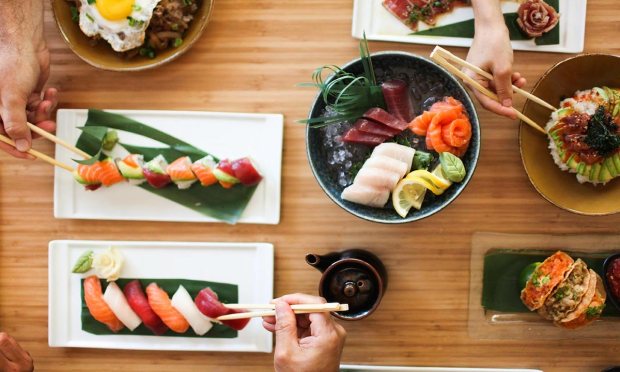Sushi Maki’s In-Store Restaurants At Whole Foods Drive Frequency While Elevating the Grocery Experience

In today’s connected economy, consumers’ restaurant and grocery routines are joining to form a broader eat category. Restaurants are driving sales through off-premise channels, meeting consumers’ food-at-home needs, and grocery stores are investing in offerings beyond raw ingredients for home-cooked meals. Many major grocery retailers are investing in their prepared meal offerings, and even opening restaurants inside their stores.
Read more: The Fresh Market Proceeds With IPO With Focus on Grocerant and Meal Kits
In the last month or so, two of the United States’ top grocers, Walmart and Kroger, announced major partnerships with virtual kitchen companies to bring restaurant brands to stores. These in-store restaurants offer grocers the opportunity to stand out, drawing in consumers with the chance to meet a greater share of their food needs. Meanwhile, for restaurants, these grocery store partnerships present a valuable opportunity to benefit from grocers’ wide audiences, offering the chance to gain new customers and become a regular part of their routines. Take, for instance, Sushi Maki, a sushi restaurant chain that currently has 12 locations inside Whole Foods Market stores.
See also: Walmart Leverages Digital Ordering Boom With 25-Brand Ghost Kitchens
“We have been working with Whole Foods since 2007 — always a lot of culinary innovation, but really as of about four years ago when Amazon purchased Whole Foods, there’s just been a whole new world of the way people buy groceries,” Abe Ng, CEO of the sushi chain, told PYMNTS in an interview. “We really are finding success in selling sushi at Whole Foods, through the [Amazon] app … We expect to continue to grow with [Whole Foods] as they continue to grow.”
The Digital Shift
Both at its in-Whole Foods locations and its other restaurants, Sushi Maki has seen its sales shift to online and mobile, as they have for so many restaurant brands. Pre-pandemic, about 40% of the restaurant’s sales were off-premise, but then, after going 100% off-premise during the early months of the outbreak, the mix settled at around 75%.
“I don’t think it’s ever going to go back to a 50/50 or 60/40 split on our part, [since] more and more people have really liked the convenience of eating sushi at home or at their offices,” said Ng.
Sure enough, research from PYMNTS’ report The Bring-It-to-Me Economy: How Online Marketplaces and Aggregators Drive Omnichannel Commerce, created in collaboration with Carat by Fiserv, found that 61% of consumers are ordering restaurant meals online, with 58% of all respondents doing so more often than before the pandemic. Additionally, almost half of all consumers are ordering food delivery more often than before March 2020.
For Sushi Maki, the brand’s ability to meet consumers’ digital developments has come alongside advances in point-of-sale (POS) technology (which enable it to keep the experience consistent across its own web and mobile portals), its third-party restaurant aggregator channels and its offerings on the Amazon app.
“Point-of-sale systems that are open-architecture on the back-end, and that integrate with a myriad of plugins — whether it’s gift cards, loyalty or, most importantly, third-party delivery — allow you to have an infinite number of points of distribution … so it’s a pretty exciting future, but one that requires a lot of strategic thought,” said Ng.
Stand by Your Brand
One of the factors to which Sushi Maki attributes its digital success is its loyalty program. Ng noted that its loyalty program helps the brand stand out against aggregators, incentivizing orders through Sushi Maki’s own channels and helping to build relationships with customers.
“Loyalty is a differentiator from ordering from our native app versus going to a third party,” said Ng. “If you can get the guests who love you to come more frequently, that’s a far better business outcome than trying to churn and burn and trying to fish for the general population.”
PYMNTS’ research from the May edition of the “Delivering on Restaurant Rewards” report, created in partnership with Paytronix, finds that about a third of consumers would be inclined to spend more at a restaurant if it offered a loyalty and rewards program, and that goes up to 37% when you look at consumers whose main pandemic-related concerns pertain to their physical or mental health.
Related news: NEW DATA: Pandemic-Related Health Concerns Shape Consumers’ Food Ordering Habits
Whole Foods, Partial Profits
With Sushi Maki’s Whole Foods locations, the chain not only splits profits with Amazon — it also makes these locations available on third-party aggregators, such that for these sales, the profits get split between the restaurant, the aggregator and Amazon.
“There are a lot of mouths to feed, so it’s got to be a win-win-win,” said Ng. “I think all three of the partners realize that this prize is a big one, and it’s a mindset of taking the long view.”
He noted that the advantages of the Whole Foods locations include that these stores are “located beautifully” and that the chain’s locations are already a combination of “food halls and grocery providers,” suggesting that its customers are already open to purchasing ready-to-eat foods as part of the shopping journey. Just as Sushi Maki benefits from Whole Foods’ audience, Whole Foods benefits from the sushi restaurant’s appeal, elevating the experience for shoppers.
“Retailers are trying to get efficient in, ‘How do you maximize the use of the [space]?’ And restaurants can be a great driver of experience,” Ng pointed out. “You can drive a visit from maybe once a month to three times a month if there’s a food offering attached.”
